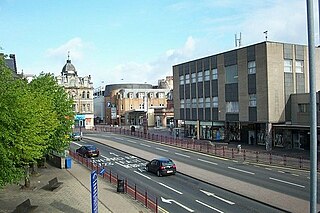
Hamilton is a large town in South Lanarkshire, Scotland. It serves as the main administrative centre of the South Lanarkshire council area. It sits 10 miles (16 km) south-east of Glasgow, 37 miles (60 km) south-west of Edinburgh and 74 miles (120 km) north of Carlisle. It is situated on the south bank of the River Clyde at its confluence with the Avon Water. Hamilton is the county town of the historic county of Lanarkshire and is the location of the headquarters of the modern local authority of South Lanarkshire.

Avon Water, also known locally as the River Avon, is a 24-mile-long (39 km) river in Scotland, and a tributary of the River Clyde.

Lanarkshire, also called the County of Lanark, is a historic county, lieutenancy area and registration county in the central Lowlands of Scotland.

Larkhall railway station serves the town of Larkhall, South Lanarkshire, Scotland. The station is the south-eastern terminus of the Argyle Line, 16+1⁄4 miles (26.2 km) south east of Glasgow Central railway station.
Ferniegair is a village across the Avon Water from Hamilton, on the A72 road to Larkhall in South Lanarkshire, Scotland.

Hamilton West railway station serves the Hamilton West area of Hamilton, South Lanarkshire, in Scotland, lying on the Argyle Line.

Chatelherault railway station serves the villages of Ferniegair and Allanton on the outskirts of Hamilton, South Lanarkshire, Scotland. It is named Chatelherault after the nearby Chatelherault Country Park.

Merryton railway station is a railway station in Larkhall, Scotland. The station is managed by ScotRail and lies on the Argyle Line.
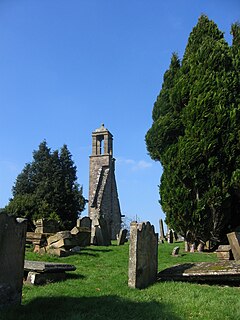
Stonehouse is a rural village in South Lanarkshire, Scotland. It is on Avon Water in an area of natural beauty and historical interest, near to the Clyde Valley. It is on the A71 trunk road between Edinburgh and Kilmarnock, near the towns of Hamilton, Larkhall and Strathaven. The population of Stonehouse is around 7,500.
Tillietudlem is a fictional castle in Walter Scott's 1816 novel Old Mortality, and a modern settlement in South Lanarkshire, Scotland.
Alton Heights Junction railway station was a short-lived station located south of Lesmahagow in the Scottish county of South Lanarkshire.
Dalserf railway station served the village of Dalserf in South Lanarkshire, Scotland, on the Coalburn branch of the Caledonian Railway line.
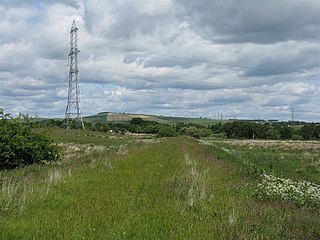
The Lesmahgow Railway, south of Glasgow in Scotland, was developed by a company known as The Lesmahagow Branches. It was not an independent company in the usual sense. It was a financially independent, self-contained unit within the framework of the Caledonian Railway. The shareholders and officers of both companies were mainly the same people. The line was built largely to transport the vast amount coal being produced by the many mines in the area. Royal assent was given to build the line in 1847 but construction did not commence till 1854. In 1856 the line was opened in stages. Later there was found to be a demand for passenger services which commenced in 1868. In 1923, with the grouping, the CR amalgamated with several other companies to form the London, Midland and Scottish Railway (LMS) which, following nationalisation in 1947, became part of British Railways.
This article traces the Caledonian Railway branches in South Lanarkshire.
The Caledonian Railway branches in North Lanarkshire built on the Caledonian Railway main line, which opened in 1848. In the following years the considerable increase of iron production and coal extraction in North Lanarkshire led to a progressive expansion of branch lines in the area between the eastern margin of Glasgow and Bellside in the east, and between Coatbridge, Airdrie and Motherwell. Mineral traffic was dominant and for some years passenger operation followed the construction of some of the mineral connections. In 1861 the Rutherglen and Coatbridge line was opened, extended later to Airdrie, rivalling the established Monkland Railways route. In 1869 the connection from Cleland to Midcalder was opened, connecting mineral sites but also forming a new passenger route to Edinburgh.
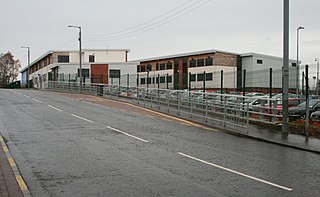
Lesmahagow High School is a non-denominational secondary school in Lesmahagow, South Lanarkshire, Scotland. The new school building opened in 2007. The current head teacher is Barbara Lee. The school has four deputy head teachers: David Robertson, Linda Wright, Pamela Docherty and Alistair Gray.
Lesmahagow railway station served the town of Lesmahagow, South Lanarkshire, Scotland, from 1866 to 1965 on the Blackwood Junction to Alton Heights Junction Line.
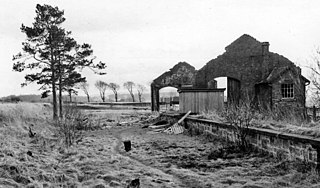
Brocketsbrae railway station served the hamlet of Brocketsbrae, South Lanarkshire, Scotland, from 1866 to 1951 on the Lesmahagow Junction to Bankend Colliery line.
















